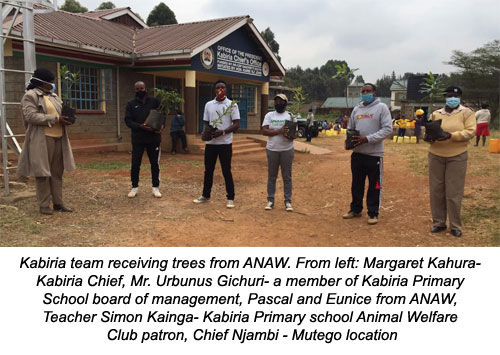Animal Welfare Updates - July 202068 Lethal Wire Snares Lifted in Nakuru and Machakos Counties’ Wildlife Areas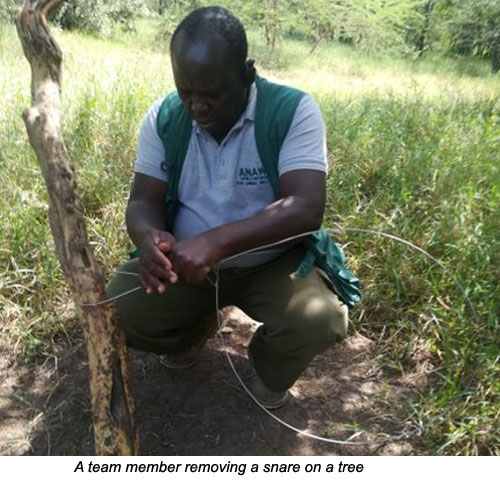
On July 1- 4, 2020, a joint de-snaring team composed of ANAW, Kenya Wildlife Service (KWS) rangers from Elementaita outpost and Soysambu Conservancy staff carried out a four-days exercise of removing wire snares set up by poachers (de-snaring) at Soysambu Conservancy in Nakuru County. The de-snaring patrol exercise saw 39 wire snares lifted hence saving potentially over 70 wild animals that would have been trapped using the same number of lethal wires. All the snares lifted were tree noose wires, set in the bushes targeting large animals. Sadly, four of the snares had made a kill catch; one killing a hyena and another three caught and killed 3 zebras. It was a chilling moment for the team as they came face to face with the evidence of the wild animals that their lives had been cut short by the snares – a rotting hyena’s carcass hanging by one of the wires; some remains of three zebras that had been trapped, slaughtered at the scene and their flesh taken away, probably for commercial or domestic use.
On 28th – 30th the same month, a similar activity was carried out in Machakos County in four ranches – Maanzoni, Kwa Kyelu, Malinda and Lukenya where 29 snares were lifted during the bushy patrols. The team learnt that there was a notorious poacher who sets wire snares late in the evening and removes them the following morning. The KWS promised to have him on their radar and arrest him at the earliest opportunity.
Seven Wild Animals Rescued; One Succumbs to Wire Pain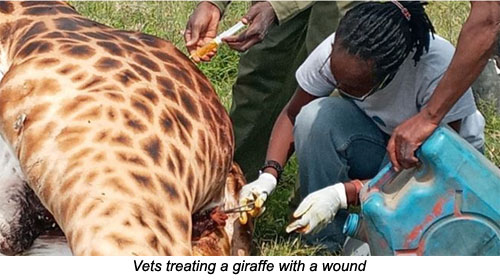
During the de-snaring patrol exercises in both Nakuru and Machakos Counties, the team also endeavored to rescue any trapped animals as well as administering medication to the injured wildlife thereof. Partnering with KWS and Animal Right Reserved (AAR) veterinary units, the team attended to seven (7) zebras and one male giraffe which had been spotted pulling wire snares. The giraffe had a laceration wound on its perineum infested with maggots. Seven of the animals were treated and released back to the wild, while one of the zebras that had a multiple foot fracture, too severe to be treated, unfortunately had to be humanely put down. Conservation Outreach Amid Covid-19
Not so, with teacher Simon Kainga from Kabiria Primary School, within Nairobi County. Teacher Simon has been in contact with his current learners as well as those who have passed through the animal welfare program in the school. The learners take turns to visit a rabbit project that they introduced in the school in 2019. In July, Simon, mobilized the area youth and spearheaded an environmental initiative within the school and the neighborhood, and in partnership with the area administration, they requested ANAW to support them acquire tree seedling from Kenya Forest Service (KFS). The ANAW team responded to teacher Simon’s call and delivered the seedlings. They were received by Teacher Simon, Margaret Kahura the Dagoreti North area chief, Mr. Urbunus Gichuhi a member of Kabiria Primary School’s Board of Management (BoM) as well as Chief Njambi of Mutego location. Chief Kahura appreciated the work ANAW has been undertaking through the animal welfare clubs in schools. She commented the willingness of ANAW to even open the program not only reaching out to the learners, but also the communities that they live in. She requested for more seedlings to be able to reach out to a wider area, and more community members. On his part, Mr. Gichuhi thanked the organization for their long running partnership with the school and added that the tree planting will change the landscape of the communities for a better Kabiria environment. Each of the participants has been assigned a number of trees to nurture, for the next six months. Chief Njambi, whose area of jurisdiction borders Ngong’ shared with the team how monkeys and baboons from the forest were a nuisance to the residents and requested ANAW for support on dealing with the challenge. A total of 150 assorted indigenous tree seedlings were planted. Count-down for Africa Animal Welfare Conference – Action 2020, Begins!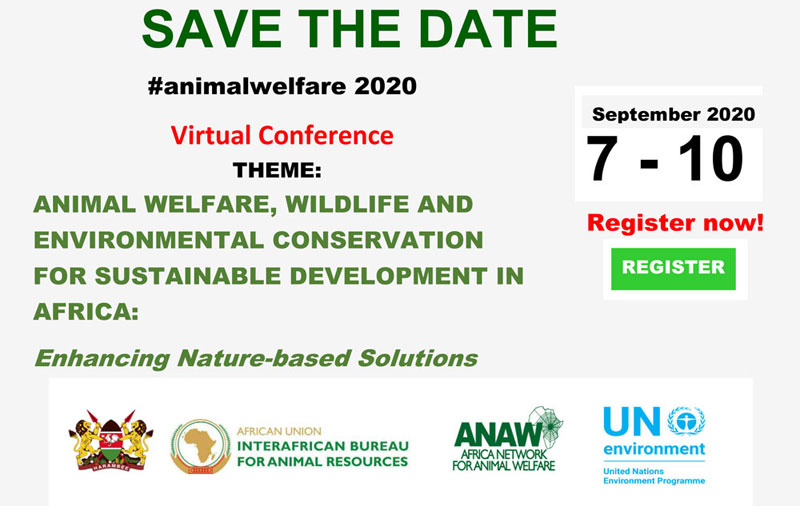
It is all systems go as count-down to the much-publicized Africa Animal Welfare Conference (AAWC) – Action 2020, to be held virtually, in less than a month, begins! The conference with the theme, ‘Animal Welfare, Wildlife and Environmental Conservation for Sustainable Development in Africa: Enhancing Nature-Based Solutions’ opens doors on 7th September and closes on 10th September this year. Interested participants are urged to register here before the fast-approaching deadline. Here is a word of welcome from the AAWC 2020 Organizing Committee Chairperson.
Support Our Work Here's a great way to support Africa Network for Animal Welfare (ANAW) and enable us to protect future generations of animals. You can do so through the following ways: Through Donation Leave a Legacy in Your Will
|

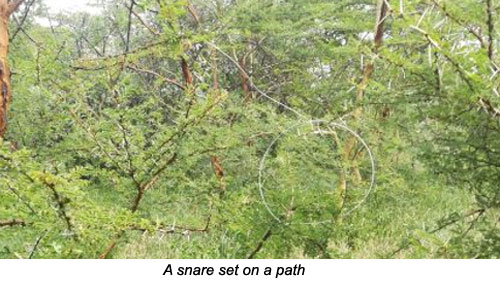 The team noted that, though the extent of bushmeat poaching was on a down-ward spiral compared to previous month where 68 wire snares had been lifted, there was still much work to be done. More poachers needed to be apprehended and news of their apprehension spread among the neighboring communities from which the poachers come, as a stern warning to other poachers that their days too, were numbered. This will deter most of them from participating in the vice.
The team noted that, though the extent of bushmeat poaching was on a down-ward spiral compared to previous month where 68 wire snares had been lifted, there was still much work to be done. More poachers needed to be apprehended and news of their apprehension spread among the neighboring communities from which the poachers come, as a stern warning to other poachers that their days too, were numbered. This will deter most of them from participating in the vice.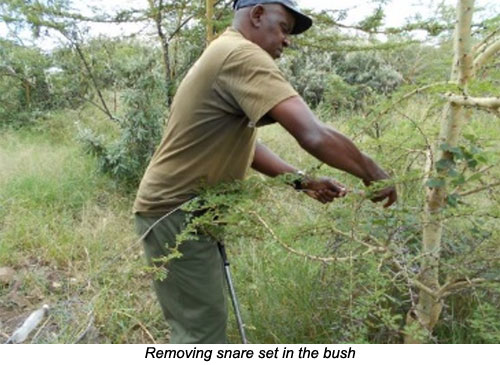 Though the level of wire snaring in the area had significantly gone down in the other three ranches (Maanzoni, Malinda and Lukenya), the KWS rangers urged the team to help in carrying out more extensive patrols specifically in Kwa Kyelu ranch. ANAW has planned more community awareness sessions in the coming months to ensure the surrounding communities are increasingly sensitized on the benefits of conserving wildlife and hence encourage them to report any suspicious poaching activities to the authorities for action.
Though the level of wire snaring in the area had significantly gone down in the other three ranches (Maanzoni, Malinda and Lukenya), the KWS rangers urged the team to help in carrying out more extensive patrols specifically in Kwa Kyelu ranch. ANAW has planned more community awareness sessions in the coming months to ensure the surrounding communities are increasingly sensitized on the benefits of conserving wildlife and hence encourage them to report any suspicious poaching activities to the authorities for action.